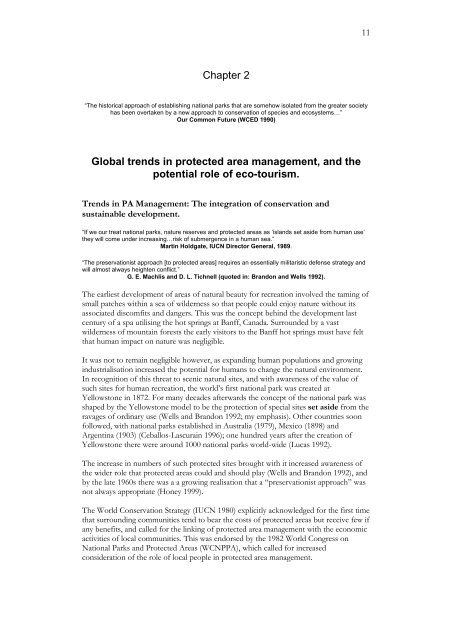The Unfenced Desert Towards a strategy for eco ... - Nwrc.gov.sa
The Unfenced Desert Towards a strategy for eco ... - Nwrc.gov.sa
The Unfenced Desert Towards a strategy for eco ... - Nwrc.gov.sa
You also want an ePaper? Increase the reach of your titles
YUMPU automatically turns print PDFs into web optimized ePapers that Google loves.
Chapter 2<br />
“<strong>The</strong> historical approach of establishing national parks that are somehow isolated from the greater society<br />
has been overtaken by a new approach to conservation of species and <strong>eco</strong>systems…”<br />
Our Common Future (WCED 1990)<br />
Global trends in protected area management, and the<br />
potential role of <strong>eco</strong>-tourism.<br />
Trends in PA Management: <strong>The</strong> integration of conservation and<br />
sustainable development.<br />
“If we our treat national parks, nature reserves and protected areas as ‘islands set aside from human use’<br />
they will come under increasing…risk of submergence in a human sea.”<br />
Martin Holdgate, IUCN Director General, 1989.<br />
“<strong>The</strong> preservationist approach [to protected areas] requires an essentially militaristic defense <strong>strategy</strong> and<br />
will almost always heighten conflict.”<br />
G. E. Machlis and D. L. Tichnell (quoted in: Brandon and Wells 1992).<br />
<strong>The</strong> earliest development of areas of natural beauty <strong>for</strong> recreation involved the taming of<br />
small patches within a sea of wilderness so that people could enjoy nature without its<br />
associated discomfits and dangers. This was the concept behind the development last<br />
century of a spa utilising the hot springs at Banff, Canada. Surrounded by a vast<br />
wilderness of mountain <strong>for</strong>ests the early visitors to the Banff hot springs must have felt<br />
that human impact on nature was negligible.<br />
It was not to remain negligible however, as expanding human populations and growing<br />
industriali<strong>sa</strong>tion increased the potential <strong>for</strong> humans to change the natural environment.<br />
In r<strong>eco</strong>gnition of this threat to scenic natural sites, and with awareness of the value of<br />
such sites <strong>for</strong> human recreation, the world’s first national park was created at<br />
Yellowstone in 1872. For many decades afterwards the concept of the national park was<br />
shaped by the Yellowstone model to be the protection of special sites set aside from the<br />
ravages of ordinary use (Wells and Brandon 1992; my emphasis). Other countries soon<br />
followed, with national parks established in Australia (1979), Mexico (1898) and<br />
Argentina (1903) (Ceballos-Lascurain 1996); one hundred years after the creation of<br />
Yellowstone there were around 1000 national parks world-wide (Lucas 1992).<br />
<strong>The</strong> increase in numbers of such protected sites brought with it increased awareness of<br />
the wider role that protected areas could and should play (Wells and Brandon 1992), and<br />
by the late 1960s there was a a growing reali<strong>sa</strong>tion that a “preservationist approach” was<br />
not always appropriate (Honey 1999).<br />
<strong>The</strong> World Conservation Strategy (IUCN 1980) explicitly acknowledged <strong>for</strong> the first time<br />
that surrounding communities tend to bear the costs of protected areas but receive few if<br />
any benefits, and called <strong>for</strong> the linking of protected area management with the <strong>eco</strong>nomic<br />
activities of local communities. This was endorsed by the 1982 World Congress on<br />
National Parks and Protected Areas (WCNPPA), which called <strong>for</strong> increased<br />
consideration of the role of local people in protected area management.<br />
11

















